Lipoma removal
A lipoma (fatty tissue) is a non cancerous (benign) lump that forms due to an overgrowth of fat cells. You can get a lipoma anywhere on the body where you have fat cells.

Lipoma removal SURGERY – FACTS
| Length of surgery | 30-60 minutes |
| Anaesthesia | Local or general anaesthetic |
| Hospital stay | Day case |
| Risks/complications of surgery | Frequent: Swelling, bruising |
| Recovery | 5-7 days facial sutures removed if used |
| Driving | Depends where the lipoma was |
| Follow up | 6 weeks |
| Duration of results | Permanent unless recurrence |
DOWNLOAD FURTHER INFORMATION
Lipoma removal
Any plastic surgery procedure is a very personal choice, and understandably there are a number of questions that arise. This information sheet is a general guide for patients considering Lipoma Removal treatment under the care of Dr Mackenzie. It should provide the answers to some questions that you may have.
What is a lipoma?
Lipomas are soft, fatty lumps that grow under the skin. Lipomas are not cancer. Cancerous tumours of the fat cells are called liposarcomas. They are a type of soft tissue sarcoma. It is very rare for lipomas to turn into a cancerous sarcoma. It is still important to tell your doctor if your lipoma changes in any way or if you get any new lumps.
They can grow anywhere in the body where there are fat cells, but are usually seen on the shoulders, neck, chest, back, arms, buttock, thigh
What are the features of a lipoma?
They feel soft and ‘doughy’ to touch and range from the size of a pea to a few centimetres across. They grow very slowly and don’t usually cause any other problems. They can move under the skin if you press them. They are usually not painful.
Who gets lipomas?
Lipomas are common. Around 1 in 100 people (1%) will develop a lipoma.
We don’t know what causes them, but some people develop them because of an inherited faulty gene. This condition is known as familial multiple lipomatosis and is not common.
People with familial multiple lipomatosis will develop more than one lipoma. The exact number they have can vary.
How is a lipoma diagnosed?
Diagnosis of lipoma is usually made clinically. Sometimes you might need an ultrasound scan of the area.
If any lipoma increases in size or becomes painful, you must tell your doctor, as it can be a sign that the lipoma is changing.
Your doctor may feel it is best to remove it or take a biopsy so that they can be certain it is a lipoma. They will also make a referral to a specialist.
What are the options for lipoma removal?
Most lipomas do not require any treatment. Occasionally, they may interfere with movement. The method recommended for lipoma removal is removal by surgical excision. The treatment will generally last around 30-60 minutes and it is carried out under local anaesthetic (unless lipomas are multiple). The lipoma is then sent for testing.